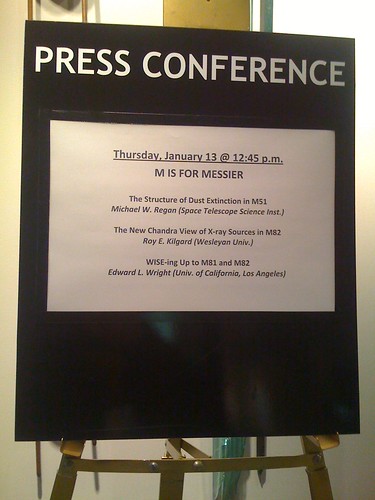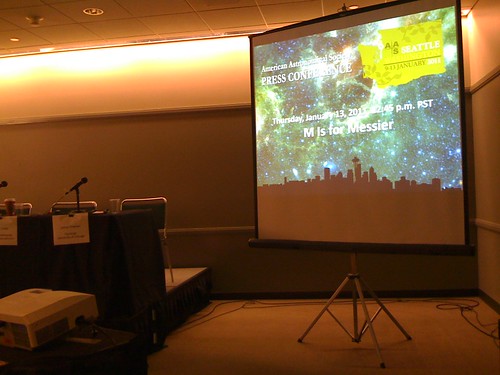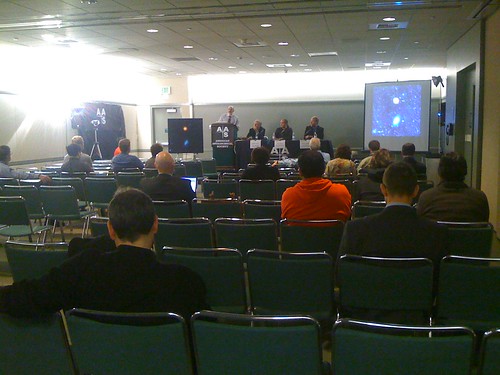Meet the Press
- By Sara Mitchell
- February 18, 2011
- 3 Comments
Some things seem very simple when you just see the end product… but behind the scenes, it can be a very different story. When Maggie was covering the American Astronomical Society meeting in Seattle a few weeks ago, she stopped in to catch one of the press conferences. It was pretty straightforward – a panel of experts showed up and briefed the audience about recent discoveries, then fielded questions. This particular conference covered a new infrared image of the dense dust in the Whirlpool Galaxy (M51), bright X-ray sources in starburst galaxy M82, and new WISE images of M82 and its “big brother” partner galaxy M81. Press conferences are a common occurrence at scientific professional meetings – having a large portion of the field represented in one location creates a great opportunity to announce discoveries, and makes it convenient for the press to cover them. But when I started thinking about telling the story of a press conference… it seemed much more interesting to tell the story of what it takes to make one happen.

I started with our inside man – Blueshift’s own Francis Reddy also happens to be the senior science writer for the Astrophysics Science Division here at Goddard. He’s got his finger on the pulse of our Division, and regularly writes stories about the work going on here that are picked up by news outlets worldwide. So how does a story get started?
Sometimes, project scientists will conveniently tell Frank about their latest results or papers they’re about to publish. But not every story comes to him, so he’s always on the lookout for candidates. When something interesting crosses his path, Frank works with relevant NASA folks to figure out if it’ll make a good news story, and what direction it should take. Frank told me, “The main considerations with anything we push out is ‘What’s new?’ and ‘Why should I care?’ with the latter usually being the toughest.” Sounds just like picking good stories for Blueshift!
There are a lot of different ways that NASA releases its news – media telecons, press releases, and web features being the most common. The choice depends on how much potential Frank and his colleagues see in the story, and the timing of the release. For media telecons and press releases, the idea has to be pitched and reviewed by a series of higher officials. If it’s approved, then work begins on getting the story ready to go – finalizing the text and visuals. Then it gets reviewed again! It takes a lot of people to make the news happen at Goddard, and all the world sees is the polished release as it is distributed around the world.
A professional society press conference is a different beast, though, and involves coordination with people outside of NASA. When I asked Frank specifically about press at the AAS meeting, he suggested that I contact Dr. Rick Fienberg, the Press Officer and Education and Outreach Coordinator for the AAS. It’s interesting to note that both Frank and Rick have backgrounds with astronomy magazines – Frank with Astronomy and Rick with Sky & Telescope. This experience is invaluable as they evaluate which stories will appeal to astronomy-interested audiences and the general public.
When I asked Rick about AAS press conferences, his answer began very similarly to Frank’s – he combs the abstracts submitted for the meeting to see if any particularly interesting stories leap out, and asks press officers at various astronomy institutions to suggest candidates. A couple of months before the meeting, Rick begins to sort through the ideas he’s gathered. How does he decide which ones are “newsworthy”? “Generally, anything involving extremes – first, biggest, smallest, most energetic, and so on – is a good candidate,” he told me, “especially if it involves hot topics like exoplanets, black holes, dark matter, or dark energy.” He groups his picks by topic, talks with the astronomers and press officers involved with each release, and makes sure that they are a good fit for a press conference. Then he starts scheduling the briefings for the upcoming meeting.
The large winter meetings, like Maggie just attended, usually have about eleven briefings, with three or four topically themed speakers apiece. That’s a lot of astronomy news released over just four days! Who can you find at these press briefings? Rick answered, “Briefings are attended by journalists, public information officers, and a smattering of the presenters’ colleagues. Presenters include graduate students, postdocs, junior researchers, and senior researchers – basically, a cross-section of typical meeting attendees, ranging from students to Nobel Prize winners.” And the audience is larger than just the folks in the room, as the AAS has begun webcasting the press briefings for those who cannot attend in person. You can check out the archived briefings on the AAS website, if you want to experience one yourself!
The Astrophysics Science Division released a couple of big stories at the latest AAS meeting, and each one had to pass through the entire process I’ve described. But the results are incredibly rewarding – check out this video from one of Frank’s releases, about Fermi’s detection of antimatter from thunderstorms here on Earth:





You and Maggie are an awesome team!
Thanks!
I love astronomy
and this Post.